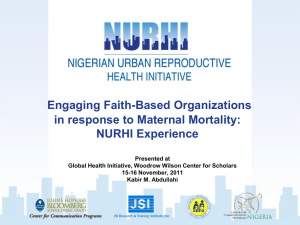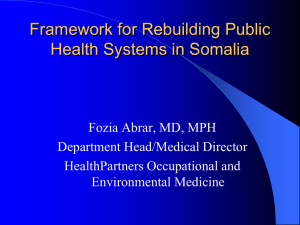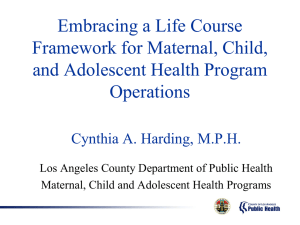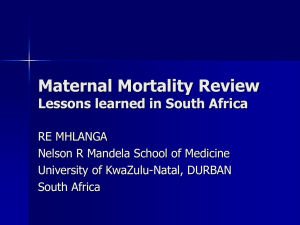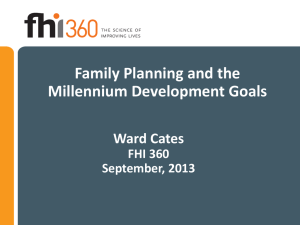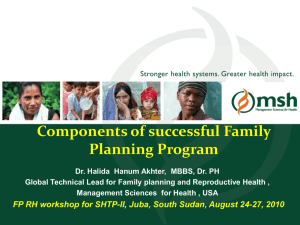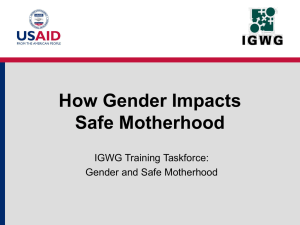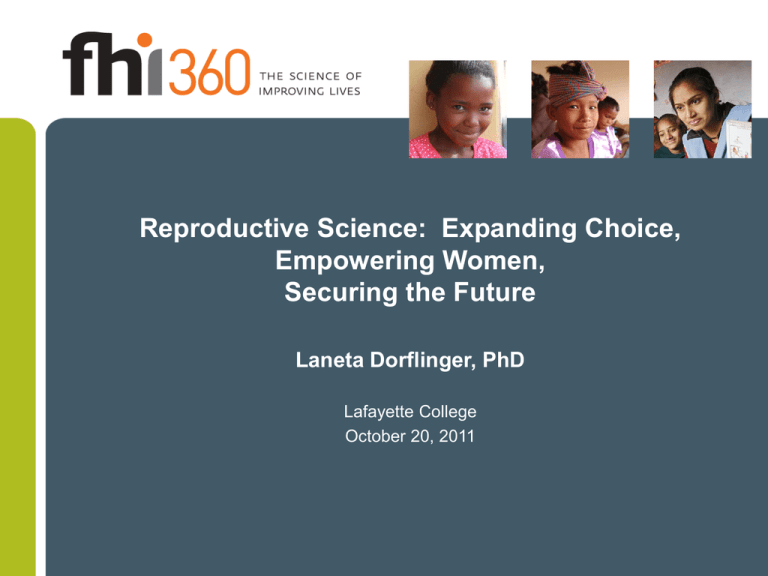
Reproductive Science: Expanding Choice,
Empowering Women,
Securing the Future
Laneta Dorflinger, PhD
Lafayette College
October 20, 2011
Expanding access to contraception
The Need is Urgent…The Time is Right
World Population to reach 10 billion by 2100 if Fertility in
all Countries Converges to Replacement Level
UNITED NATIONS, 3MAY, 2011 – The current world population of close to 7 billion is
projected to reach 10.1 billion in the next ninety years, reaching 9.3 billion by the
middle of this century, according to the medium variant of the 2010 Revision of
World Population Prospects
Of the nearly 7 billion people in the world today
• 1.4 billion (20%) are living on less
than US$1.25 a day
• 48% live on less that $2 per day
• 2.6 billion (37%) have no access
to toilets, latrines or other forms of
improved sanitation
• Over 33 million are living with HIV
• Average per capita health care
expenditures in sub-Saharan
Africa < $100
Source: Millennium Development Goals and
PBR 2011 Population Datasheet
Ensuring access - Expanding choice
Presentation Outline
• Overview of global fertility and contraceptive use
• Maternal mortality and morbidity
– Role of family planning in reducing maternal death
• The contribution of family planning to achieving the
Millennium Development Goals (MDGs)
• Current contraceptive technology
• Need for new technologies
• Areas of research that could fill greatest gaps
• Economic realities of expanding access and choice
Presentation Outline
• Overview of global fertility and contraceptive use
• Maternal mortality and morbidity
– Role of family planning in reducing fertility and
maternal death
• The contribution of family planning to achieving the
Millennium Development Goals (MDGs)
• Current contraceptive technology
• Need for new technologies
• Areas of research that could fill greatest gaps
• Economic realities of expanding access and choice
Total fertility rates and modern contraceptive
method prevalence
Total Fertility Rate (TFR)
•
•
Modern Contraceptive Prevalence (CPR)
Highest fertility rates and lowest modern contraceptive prevalence rates
are found in Africa and South/Western Asia.
Highest numbers of women needing family planning services are in
South/Western Asia.
Source: PRB 2010 World Population Data Sheet
Contraceptive use and method by region
Percentage of married women
Any Method
Any Modern
Method*
Total Fertility
Rate
World
62.7
56.1
2.5
North America
78.1
72.9
1.9
LAC
72.9
67.0
2.2
East Asia
82.8
81.3
1.5
South Asia
53.9
45.8
2.7
Sub-Saharan
Africa
28.6
15.7
5.2
Region
* Modern methods include male/female sterilization, pills, IUD, injectable,
implants, condoms, female barriers, EC
20
04
ig
er
2
ha
d
G
00
ui
6
ne
a
20
05
M
al
i2
00
Be
1
ni
n
20
N
01
ig
er
Bu
ia
rk
20
in
a
03
Fa
so
20
Se
03
ne
ga
l2
R
00
w
an
5
da
C
20
am
05
er
oo
n
20
Et
hi
04
op
ia
20
G
05
ha
na
20
U
03
ga
nd
M
ad
a
20
ag
06
as
ca
r2
Ta
00
nz
4
a
ni
M
a
oz
20
am
04
bi
qu
e
20
Za
03
m
bi
a
20
M
02
al
aw
i2
00
Ke
4
ny
a
Zi
20
m
ba
03
bw
e
20
06
N
C
Percent MWRA
Contraceptive Use and Unmet Need in Africa
80
70
60
50
40
30
20
10
0
Modern CPR
Trad CPR
Unmet Need
Courtesy of Scott Radloff, USAID, 2011
Unmet need of 215 million in developing
countries translates to:
53 million unintended pregnancies, leading to:
•
24 million abortions
•
150,000 pregnancy-related deaths [1/2 in Africa]
•
640,000 newborn deaths
•
600,000 orphans
Source: Guttmacher Policy Review, Summer 2008, Vol 11, Number 3
Presentation Outline
• Overview of global fertility and contraceptive use
• Maternal mortality and morbidity
– Role of family planning in reducing fertility and
maternal death
• The contribution of family planning to achieving the
Millennium Development Goals (MDGs)
• Current contraceptive technology
• Need for new technologies
• Areas of research that could fill greatest gaps
• Economic realities of expanding access and choice
Measuring maternal mortality
• Total number of deaths
– While pregnant or within 42 days of termination, due to complications of
pregnancy or childbirth
• Maternal mortality ratio
– Number of maternal deaths during a given time per 100,000 live births
– Indicator of the quality of the health care system
• Maternal mortality rate
– Number of maternal deaths during a given time per 100,000 WRA
– Influenced by prevalence of pregnancy and risk of dying from a pregnancy
• Lifetime risk of death
– Probability that at 15 year old will die in her lifetime of maternal causes
– Influenced by number of pregnancies, spacing of pregnancies, and the
quality of the health care system
Figure 3
Maternal mortality ratio for 181 countries, 2008
Source: Hogan et al. The Lancet 2010; 375:1609-1623
Lifetime risk of maternal death
Region
Lifetime risk of
maternal death
(1 in X)
World Total
Developed
Developing
140
4,300
120
South Asia
110
Sub-Saharan Africa
31
Middle East/N Africa
190
Source: Trends in Maternal Mortality 1990-2008.
WHO, UNICEF, UNFPA and The World Bank.
Maternal Mortality Worldwide, 2008
• Estimated numbers: 342,900
– Down from 526,300 in 1980
• More than 60% of all deaths occur in just 6 countries
–
–
–
–
–
–
India
Nigeria
Pakistan
Afghanistan
Ethiopia
DRC
Source: Hogan et al. The Lancet 2010; 375:1609-1623
World’s worst airline disaster
Tenerife, Canary Islands on March 27,1977
Two Boeing 747’s collided on the runway in fog
583 dead
Slide courtesy of Dr. David Grimes
Annual global maternal mortality
939 Boeing 777’s
fully loaded with
women aged 15-45
or….
More than two
planes per day
Slide courtesy of Dr. David Grimes
Maternal morbidity
• Disabilities are estimated to be 20 times more
frequent than maternal deaths
• The ratio of “near misses” ranges from 1:5 to
1:118
Source: Lewis. Br Med Bull 2003;67:27
Primary health center and “Zambulance”
Suburban area of Lusaka, Zambia
Courtesy of Dr. Cindy Geary, FHI 360
Family Planning Reduces Maternal Mortality
Contraceptive
Prevalence*
73%
Lifetime
probability of
maternal death
(1/X)
2,100
India
49%
140
Malawi
38%
36
Nigeria
9%
23
COUNTRY
US
* Percent of married women ages 15-49 using modern method
Source: PRB World Population Datasheet, 2011 and Save the Children
State of the World’s Mothers, 2011
Unsafe Abortion
• About 15% of maternal deaths are related to
unsafe abortion
•
An estimated 50,000 to 60,000 women die each
year from unsafe abortion
•
Almost all of these deaths occur in developing
countries
•
Almost all are preventable
Grimes. Lancet 2006;368:1908
Increased use of modern contraceptive
methods reduces rates of abortion
Slide courtesy of Scott Radloff, USAID, 2011
Presentation Outline
• Overview of global fertility and contraceptive use
• Maternal mortality and morbidity
– Role of family planning in reducing fertility and
maternal death
• The contribution of family planning to achieving the
Millennium Development Goals (MDGs)
• Current contraceptive technology
• Need for new technologies
• Areas of research that could fill greatest gaps
• Economic realities of expanding access and choice
Millennium Development Goals
• Goals to end poverty
and inequality
• Targets for global
development
• Commitments by 189
countries
• Priorities for funding
• Opportunities for
multinational
organizations
Millennium Development Goals – by 2015
• End Poverty and Hunger
• Universal Education
• Gender Equality
• Child Health
• Maternal Health
•
Reduce maternal mortality by three-fourths
•
Achieve universal access to reproductive health
• Combat HIV/AIDS
• Environmental Sustainability
• Global Partnership
Family Planning Prolongs Education
• Pregnancy a major obstacle to universal
education for women
• High levels of pregnancy in youth
• Fewer than half of African girls complete primary
school
• Population growth puts pressure on limited
education infrastructure
– Girls suffer disproportionately
Teenage Pregnancy and Motherhood
(Percent with children or currently pregnant)
Country
Age
16
17
18
19
Kenya 2008
9.4
16.5
26.2
36.2
Malawi 2010
12.6
21.7
43.4
63.5
Uganda 2006
8.5
25.5
41.0
58.6
Nigeria 2008
13.0
24.2
35.7
38.4
India 2005/06
6.4
12.5
24.0
35.7
Bangladesh 2007
18.6
33.4
42.5
58.5
Source: Demographic and Health Surveys
(DHS), Macro
Family planning enhances gender equity and
empowers women
• Women who use FP more likely to be employed
than non-users (Indonesia, Zimbabwe, Bolivia)
• Unplanned pregnancies interrupt work and
career plans (Egypt)
• Long-acting/permanent contraceptive methods
associated with greater likelihood of working for
pay (Brazil, Indonesia)
• Girls in larger families were less likely to attend
school than girls from households with smaller
families (Ghana)
Sources: Woman’s Studies Project;
UNFPA, 2003
Family Planning Saves Infants
• Maternal death increases risk of newborn infant
death
• Currently, 2.7 million infant deaths are averted
globally each year by preventing unintended
pregnancies
• Spacing planned births and limiting unintended
births increases child survival
Source: Demographic and Health Surveys
Child Mortality by Birth Interval
Relative Risk Child Mortality
3.5
3
2.5
2
1.5
1
0.5
0
<18
18-23
24-29
30-35
36-41
42-47
48-53
54-59
60+
Duration of Preceding Birth Interval (Months)
Source: DHS; Rutstein S. (2005)
Family Planning Prevents HIV
4 Phase Approach to Perinatal HIV Prevention
Four-phased approach to preventing perinatal HIV transmission
Prevention of
HIV in
women,
especially
young
women
Prevention of
unintended
pregnancies
in HIVinfected
women
Prevention of
transmission
from an HIVinfected
woman to her
infant
Phase 1
Phase 2
Phase 3
Support for
mother and
family
Phase 4
Unintended pregnancies among women with
HIV in Africa
• 51% of pregnancies are unintended among
women with HIV in Cote d’Ivoire
• 74% of pregnancies are unintended among
women in an ART treatment program in Rwanda
• 84% of pregnancies are unintended among
women using PMTCT services in South Africa
Sources: Rochat et al., JAMA 2006:295:1376-8;
Desgrées-du-Loû et al., Int J STD AIDS 2002;13:462-468;
Bangendanye, et al., Presented November 2007.
Family planning protects the environment
• Rapidly growing population
– challenges constrained resources (arable land,
clean water)
– exacerbates environmental degradation
– exacerbates food insecurities
• Preventing unintended pregnancy is the
factor in population growth most amenable
to intervention
Source: Population Reference Bureau, 2009
Family Planning Critical to Achieving MDGs
Reduced
child mortality
Improved
maternal
health
Gender
equity
Universal
primary
education
Eradication of
poverty
Combatting
HIV/AIDS
Sexual
Environmental
sustainability
and
reproductive
health
Courtesy of Jeff Spieler, USAID. Adapted from HRP/RHR/WHO
Global
partnership
for
development
Presentation Outline
• Overview of global fertility and contraceptive use
• Maternal mortality and morbidity
– Role of family planning in reducing fertility and
maternal death
• The contribution of family planning to achieving the
Millennium Development Goals (MDGs)
• Current contraceptive technology
• Need for new technologies
• Areas of research that could fill greatest gaps
• Economics realities of expanding access and choice
Current contraceptive methods and typical effectiveness
More effective
How to make your
method most effective
Less than 1 pregnancy per
100 women in one year
After procedure, little or nothing
to do or remember
Implant
Female
Sterilization
Vasectomy
IUD
Vasectomy: Use another method
for first 3 months
Injections: Get repeat injections
on time
LAM (for 6 months): Breastfeed
often, day and night
Pills: Take a pill each day
Injectables
Ring
Patch
Pills
LAM
Patch, ring: Keep in place,
change on time
Condoms, diaphragm, sponge,
withdrawal: Use correctly every
time you have sex
.
Male
Condoms
Female
Condoms
Sponge
Diaphragm
Withdrawal
Spermicide: Use correctly every
time you have sex
Less effective
About 25 pregnancies per
100 women in one year
Spermicide
Fertility-Awareness
Based Methods
Source: Adapted from WHO 2006
Fertility-awareness based
methods: Abstain or use
condoms on fertile days.
Pregnancy risk and continuation rates for
select contraceptive methods at one year
Method
Perfect Use
Typical Use
No method
85
85
Male condom
2
18
Pill, Patch, Ring
0.3
9
Depo-Provera
0.2
6
Copper-IUD
0.6
0.8
Mirena
0.2
0.2
Implanon
0.05
0.05
Female sterilization
0.5
0.5
Male sterilization
0.10
0.15
Source: Trussell, Contraception 2011; 83:397-404.
Pregnancy risk and continuation rates for
select contraceptive methods at one year
Method
Perfect Use Typical Use
Percent
Continuing
No method
85
85
Male condom
2
18
43
Pill, Patch, Ring
0.3
9
67
Depo-Provera
0.2
6
56
Copper-IUD
0.6
0.8
78
Mirena IUS
0.2
0.2
80
Implanon (implant)
0.05
0.05
84
Female
sterilization
0.5
0.5
100
Male sterilization
0.10
0.15
100
Source: Trussell, Contraception 2011; 83:397-404.
Benefits of Implants vs. Shorter-acting Methods
If 20% of OC or injectable
users in Africa switched to
implants -- over next 5 years,
it would avert:
• 1.8 million unplanned pregnancies
• 576,000 abortions
• 10,000 maternal deaths
The impact would be even more dramatic adding new users
Similar impact with a shift to IUDs.
Hubacher, Mavranezouli, and McGinn, Contraception 2008
Presentation Outline
• Overview of global fertility and contraceptive use
• Maternal mortality and morbidity
– Role of family planning in reducing fertility and
maternal death
• The contribution of family planning to achieving the
Millennium Development Goals (MDGs)
• Current contraceptive technology
• Need for new technologies
• Areas of research that could fill greatest gaps
• Economic realities of expanding access and choice
Why do we need more technology?
• Existing methods do not meet the needs of all
• Some are difficult to use consistently and correctly
‒ High typical use failure rates
‒ High discontinuation
• Side effects or fear of side effects
• Changing needs and desires over reproductive lifespan
• Missing a spectrum of male methods
Target qualities for new contraceptive methods
• Highly effective in typical use
– Forgiving of misuse
– User-independent
• Safe and Acceptable
–
–
–
–
Minimal side effects or
Have “desirable” side effects (e.g. amenorrhea)
Convenient and easy to use
Use in chronic disease states
• Provide additional health benefits
• Very low cost
• Potential for wide availability
– Provided by low level health care providers or be provider
independent
Ratio of Health Provider to Population
WHO estimated
health personnel
threshold: 2.5/1000
Health workers (per 1000 population)
3
2.5
2
doctors
nurses and midwives
1.5
total (doctor, nurse, and midwife)
Community Health Workers
1
0.5
0
Lesotho
2003
Malawi
2008
Rwanda
2005
Uganda
2005
Zimbabwe
2004
Courtesy of Scott Radloff, USAID, 2011
Improving upon existing methods
• Less expensive (“generic” or “alternative”)
– Implant systems
– Levonorgestrel IUS
• Easier to use in a compliant way
– Vaginal rings
• Easier to deliver in service settings
– Preloaded injectable systems (e.g. Depo SC in
Uniject)
– Biodegradable implants
• Multipurpose technologies (Dual protection)
Sino-implant (II)/Zarin
• Two thin, flexible silicone rods, each
containing 75 mg levonorgestrel
• The same amount of active
ingredient and mechanism of action
as Jadelle
• Currently labeled for four years of
use
• Available with disposable trocar
• About $8 compared with $20-$24
for Jadelle
Population Council Nes/EE vaginal ring
Designed to
last one year
Depo-subQ Provera 104 delivery in Uniject
Depo-subQ Provera 104:
New formulation for subQ injection
30% lower dose (104 mg vs. 150 mg)
Approved by USFDA (2005) and EMA/UK
Uniject:
Single dose, prefilled, sterile, non-reusable
Easier to use by non-clinical personnel/CHWs
Compact; easy to use and store
Potential for home- and self-injection
Approval by EMA. LDC registration forthcoming
Lower-cost alternative to Mirena
Oral contraceptives
Intrauterine devices
• Highly effective
• No daily motivation
• Reduction of menstrual loss
• Long-acting
• Reduction of pelvic inflammatory • Estrogen-free
disease
• Rapidly reversible
Levonorgestrel
intrauterine system
The levonorgestrel intrauterine system
Rate-controlling
membrane
Hormone cylinder
Levonorgestrel
intrauterine
system
Detail
Uterine
wall
Section of
system
New methods that could be game changers
• Non-surgical methods of male and female sterilization
• Reversible male methods
• Dual protection methods (multipurpose technologies)
• Highly-effective peri-coital or post-coital method
• Immunocontraception (women and men)
• Methods with non-contraceptive health benefits
Presentation Outline
• Overview of global fertility and contraceptive use
• Maternal mortality and morbidity
– Role of family planning in reducing fertility and
maternal death
• The contribution of family planning to achieving the
Millennium Development Goals (MDGs)
• Current contraceptive technology
• Need for new technologies
• Areas of research that could fill greatest gaps
• Economic realities of expanding access and choice
Family Planning Saves Dollars
• Preventing unintended pregnancies is less expensive
than treating maternal/ infant complications of
pregnancy
• Longer acting contraceptive methods are the most
cost-effective
• Every $1 spent on family planning can avert $2 to $9
in health costs
• In Zambia, for every $1 invested in FP, $4 are saved
in other development areas
Family Planning and MDGs - Cost Savings
Total Savings: $111 M
120
Malaria $4 M
100
80
60
40
20
Maternal Health
$37 M
Water Sanitation
$17 M
Immunization
$17 M
Education
$37 M
0
Source: USAID-Zambia (2008)
Total Costs: $27 M
Family Planning
$27 M
$ Billions Appropriated
US Funding for HIV and Family Planning
Source: CRS (2010)
US Humanitarian and development assistance
Save the Children analysis – 2011
Sources: OMB; White House; FY 2011 CR extension
New commitments
• World Bank 5-year plan for 58 countries
• UN Secretary General’s Global Strategy for Women’s
and Children’s Health
• International Alliance for Reproduction, Maternal and
Newborn Health
– US, UK, Australia, BMGF
– Pledge of $40 billion ($27 billion new)
– Reduce unmet need by 100 million
– Expand skilled birth attendants
– Expand post-natal care
Putting costs in perspective
• Americans spent approximately $6 billion in 2010 on
Halloween costumes/candy/decorations (National Retail
Foundation, 2011)
• Estimated $3.5 billion needed to fulfill global unmet
need and prevent:
– 53 million unintended pregnancies
– 640,000 newborn deaths
– 150,000 pregnancy-related deaths
– $5.1 million expenditures on health-related services
Conclusions
• Ensuring access to family planning is a critical
component to the solution of many of the world’s
complex issues
– Expanding choice of the number and spacing
of children
– Improving the health of women
– Improving the health of children
– Addressing multiple challenges of societies
• Education, employment, environment, national
and global security
– Empowering women
– Securing the future
Some fun web sites to visit
•
•
•
•
•
•
•
www.fhi360.org
www.prb.org
www.guttmacher.org
www.popcouncil.org
www.statcompiler.com
www.measuredhs.com
www.usaid.gov/our_work/global_health/pop/techareas/inde
x.html
• www.gatesfoundation.org
• www.nrf.com/modules.php?name=Dashboard&id=54
Thank you!
www.7billionactions.org
Drivers of Population Growth
10
9
9.2
8
8.3
7
7.5
High desired family size
6
6.8
Population momentum
Unwanted fertility
5
4
3
2
0
1900
1950
2000
Year
2050
2100
Source: Adapted from Bongaarts (2010)
Small changes in fertility can have significant population effects
over time
Sequential Age Pyramids for Africa
in 1960, 1990, & 2010
80-84
70-74
60-64
50-54
Male
Female
40-44
30-34
20-24
10-14
0-4
-80,000
-70,000
-60,000
-50,000
-40,000
-30,000
-20,000
-10,000
0
0
10,000
20,000
30,000
Number for each age group in 1,000
40,000
50,000
60,000
70,000
80,000
Source: John May, World Bank
* Population growth rates: 2.5% translates to a 28 year doubling time and rapidly expanding
demands on food, water, schools, health services, energy, infrastructure, and land.
* Dependency Ratio: 78 children per 100 workers, compared to 42 in LAC, 39 in Asia, 25 in MDCs.
* Momentum: young age structure ensures continued population growth for generations.

